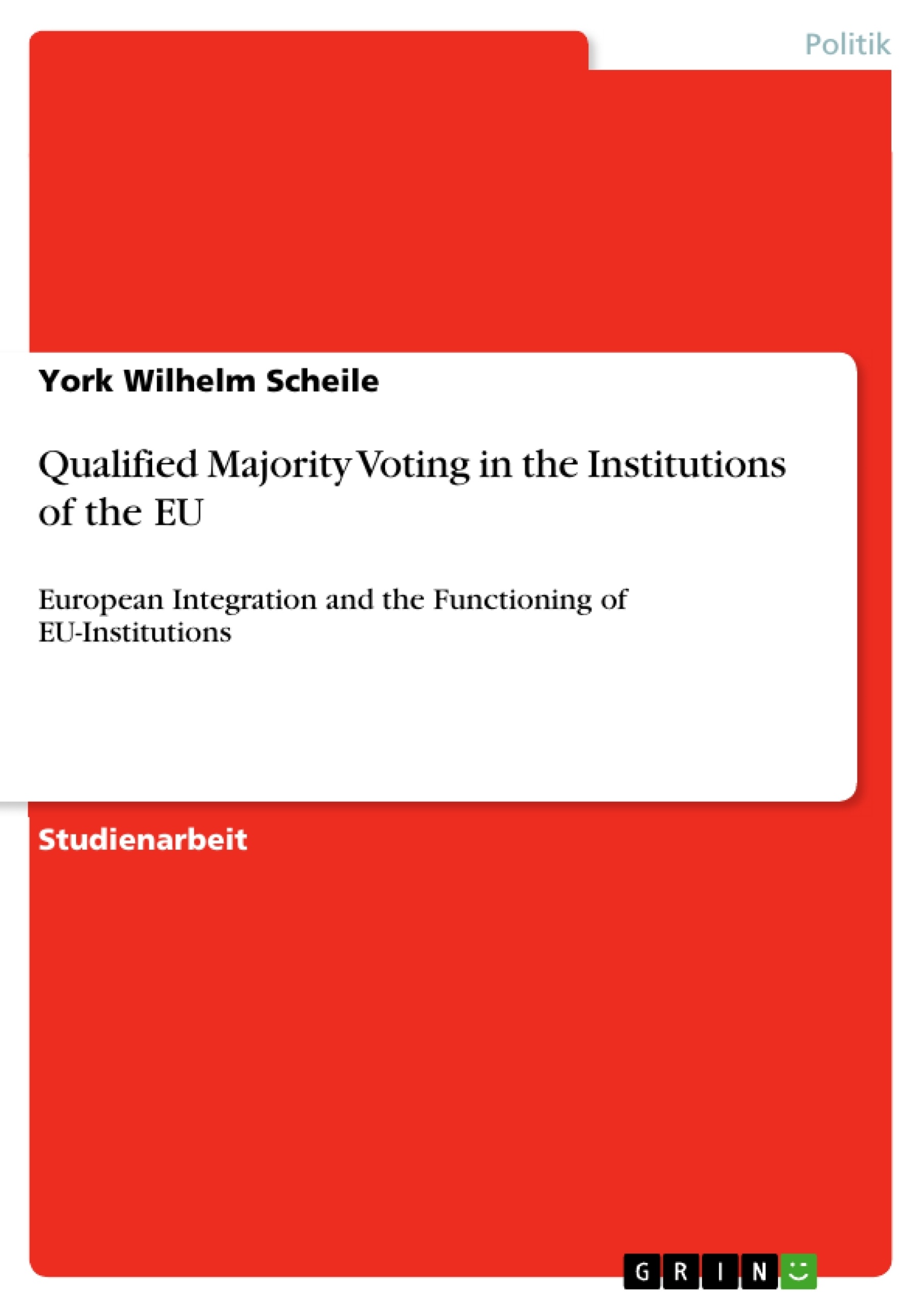The essay shows the changing of qualified majority voting in the institutions of the European Union focusing on the Council of the European Union throughout its history. Therefore, not only changes concerning the legal basis – which means the treaties of the European Union and its predecessors – but developments in the member states as well will be subject of this work, touching the question of reasoning qualified majority voting. In the end a conclusion is drawn reflecting the purpose and its ways of contributing to the decision making process of the European Union with regard to roles of big and small states.
Inhaltsverzeichnis
- Einführung
- Qualifizierte Mehrheit
- Definition
- Aktuelle Funktionsweise
- Änderungen im System der qualifizierten Mehrheit
- Ergebnis
Zielsetzung und Themenschwerpunkte
Diese Arbeit untersucht die Entwicklung der qualifizierten Mehrheit im Rat der Europäischen Union. Sie beleuchtet die Veränderungen der rechtlichen Grundlagen (EU-Verträge und Vorgänger) und die Entwicklungen in den Mitgliedsstaaten, um die Gründe für die qualifizierte Mehrheit zu verstehen. Der Fokus liegt auf der Rolle der qualifizierten Mehrheit im Entscheidungsprozess der EU und der Berücksichtigung der Interessen großer und kleiner Staaten.
- Entwicklung der qualifizierten Mehrheit in der EU
- Rechtliche Grundlagen der qualifizierten Mehrheit
- Einfluss der qualifizierten Mehrheit auf den Entscheidungsprozess der EU
- Rolle großer und kleiner Mitgliedsstaaten
- Schutz von Minderheiten im Rahmen der qualifizierten Mehrheit
Zusammenfassung der Kapitel
Einführung: Die Einführung beschreibt die Entstehung der Europäischen Integration nach dem Zweiten Weltkrieg, beginnend mit den Ideen von Jean Monnet und der Schuman-Erklärung. Sie skizziert die Entwicklung von der Europäischen Kohle- und Stahlgemeinschaft (EGKS) über die Römischen Verträge (EWG und Euratom) bis hin zu den späteren Anpassungen der Entscheidungsfindungsprozesse durch verschiedene Verträge. Der Fokus liegt auf dem historischen Kontext und der Entwicklung der europäischen Integration als Grundlage für das Verständnis der qualifizierten Mehrheit.
Qualifizierte Mehrheit: Definition: Dieses Kapitel definiert die drei Abstimmungsmethoden im Rat der Europäischen Union: Einstimmigkeit, einfache Mehrheit und qualifizierte Mehrheit. Es wird erläutert, in welchen Fällen welche Abstimmungsmethode angewendet wird, wobei der Schwerpunkt auf der qualifizierten Mehrheit liegt. Der Abschnitt beschreibt die Funktionsweise der qualifizierten Mehrheit und ihre Bedeutung im Kontext der Entscheidungsfindung der EU.
Qualifizierte Mehrheit: Aktuelle Funktionsweise: Dieses Kapitel erklärt die aktuelle Funktionsweise der qualifizierten Mehrheit, die auf einer doppelten Mehrheit basiert (55% der Mitgliedstaaten, 65% der EU-Bevölkerung). Es wird die Funktionsweise des Systems vor und nach dem Inkrafttreten des neuen Systems am 1. November 2014 detailliert dargestellt, einschließlich der Anwendung des Ioannina-Kompromisses zum Schutz von Minderheiten. Die unterschiedlichen Mechanismen zur Vermeidung von Blockaden werden erläutert und ihr Einfluss auf die Entscheidungsfindung analysiert.
Änderungen im System der qualifizierten Mehrheit: Dieses Kapitel beschreibt die historischen Veränderungen im System der qualifizierten Mehrheit, ausgehend von den verschiedenen Verträgen der Europäischen Union. Es analysiert die Anpassungen an die wachsende Zahl der Mitgliedsstaaten und die damit verbundenen Herausforderungen für die Entscheidungsfindung. Der Fokus liegt auf den jeweiligen Anpassungen der Abstimmungsmechanismen und deren Auswirkungen auf die Machtverhältnisse innerhalb der EU.
Schlüsselwörter
Qualifizierte Mehrheit, Europäische Union, Rat der Europäischen Union, Entscheidungsfindung, EU-Verträge, Minderheitenschutz, Ioannina-Kompromiss, Mitgliedsstaaten, Integrationsprozess, Gesetzgebung.
Häufig gestellte Fragen (FAQs) zur qualifizierten Mehrheit im Rat der Europäischen Union
Was ist der Inhalt dieses Dokuments?
Dieses Dokument bietet einen umfassenden Überblick über die qualifizierte Mehrheit im Rat der Europäischen Union. Es beinhaltet ein Inhaltsverzeichnis, eine Beschreibung der Zielsetzung und der Themenschwerpunkte, Zusammenfassungen der einzelnen Kapitel und eine Liste der Schlüsselwörter. Der Fokus liegt auf der Entwicklung, der Funktionsweise und den Auswirkungen der qualifizierten Mehrheit auf den Entscheidungsprozess der EU.
Was sind die wichtigsten Themen des Dokuments?
Die zentralen Themen sind die Entwicklung der qualifizierten Mehrheit in der EU, ihre rechtlichen Grundlagen, ihr Einfluss auf den Entscheidungsprozess, die Rolle großer und kleiner Mitgliedsstaaten, sowie der Schutz von Minderheiten. Das Dokument beleuchtet die historische Entwicklung, die aktuellen Mechanismen (inklusive des Ioannina-Kompromisses) und die Anpassungen an die wachsende Zahl der Mitgliedstaaten.
Wie ist die qualifizierte Mehrheit definiert?
Das Dokument definiert die qualifizierte Mehrheit im Kontext der drei Abstimmungsmethoden im Rat der EU: Einstimmigkeit, einfache Mehrheit und qualifizierte Mehrheit. Es erläutert, wann welche Methode angewendet wird und beschreibt detailliert die Funktionsweise der qualifizierten Mehrheit, insbesondere die derzeitigen Anforderungen (55% der Mitgliedstaaten, 65% der EU-Bevölkerung).
Wie funktioniert die qualifizierte Mehrheit aktuell?
Die aktuelle Funktionsweise der qualifizierten Mehrheit basiert auf einer doppelten Mehrheit. Das Dokument erklärt die Funktionsweise vor und nach dem Inkrafttreten des neuen Systems am 1. November 2014 und beschreibt detailliert Mechanismen zur Vermeidung von Blockaden, inklusive der Anwendung des Ioannina-Kompromisses zum Schutz von Minderheiten.
Welche Veränderungen hat das System der qualifizierten Mehrheit erfahren?
Das Dokument beschreibt die historischen Veränderungen im System der qualifizierten Mehrheit, die mit der Erweiterung der EU und den Anpassungen der verschiedenen EU-Verträge einhergehen. Es analysiert die Herausforderungen für die Entscheidungsfindung, die sich aus der wachsenden Anzahl der Mitgliedsstaaten ergeben haben, und die Anpassungen der Abstimmungsmechanismen.
Welche Rolle spielen große und kleine Mitgliedsstaaten?
Das Dokument untersucht die Rolle großer und kleiner Mitgliedsstaaten im Kontext der qualifizierten Mehrheit und analysiert, wie die Interessen dieser Staaten im Entscheidungsprozess berücksichtigt werden. Der Fokus liegt insbesondere auf der Frage des Minderheitenschutzes.
Welche Schlüsselwörter beschreiben den Inhalt?
Schlüsselwörter sind: Qualifizierte Mehrheit, Europäische Union, Rat der Europäischen Union, Entscheidungsfindung, EU-Verträge, Minderheitenschutz, Ioannina-Kompromiss, Mitgliedsstaaten, Integrationsprozess, Gesetzgebung.
Wie wird der Minderheitenschutz im Rahmen der qualifizierten Mehrheit gewährleistet?
Das Dokument erläutert den Minderheitenschutz im Kontext der qualifizierten Mehrheit, unter anderem durch die Erwähnung und Beschreibung des Ioannina-Kompromisses. Dieser Kompromiss dient der Vermeidung von Blockaden und dem Schutz der Interessen von Minderheiten innerhalb des EU-Entscheidungsprozesses.
Welche historischen Entwicklungen werden behandelt?
Das Dokument behandelt die historische Entwicklung der europäischen Integration, beginnend mit der Gründung der EGKS und den Römischen Verträgen, bis hin zu den späteren Anpassungen der Entscheidungsfindungsprozesse. Es wird der Kontext der Entstehung der qualifizierten Mehrheit im historischen Verlauf der europäischen Integration dargestellt.
- Quote paper
- York Wilhelm Scheile (Author), 2015, Qualified Majority Voting in the Institutions of the EU, Munich, GRIN Verlag, https://www.grin.com/document/334535




